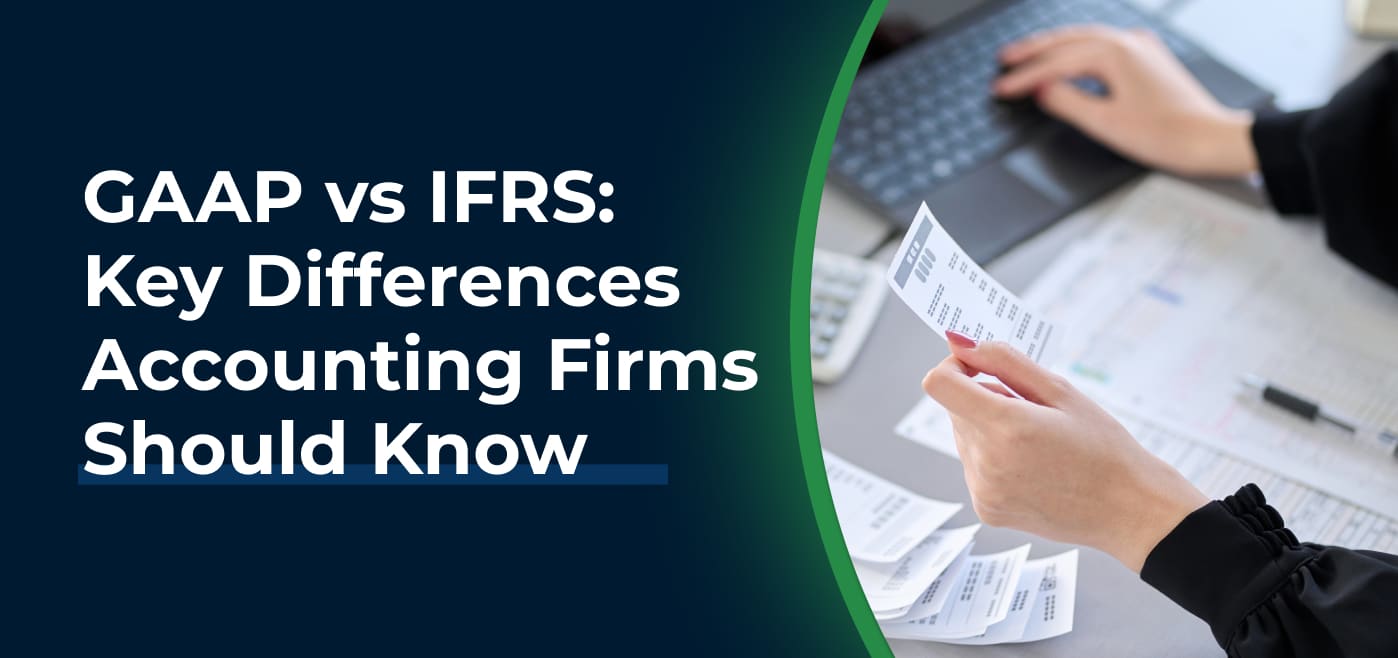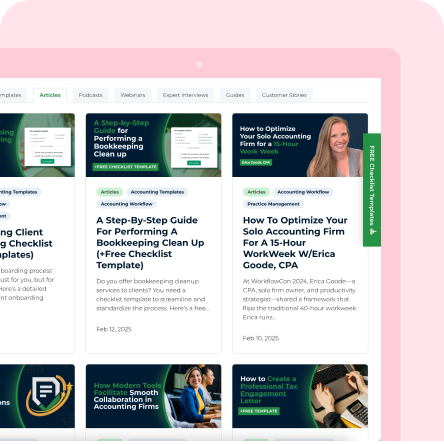If you’ve ever onboarded a client with operations in both the U.S. and Europe, you know how confusing accounting standards can get. What counts as a “standard practice” in one country might need a complete adjustment in another. For many firms, that confusion usually comes down to two major frameworks: GAAP and IFRS.
As you take on more global clients, you need to understand that both systems are essential. Thanks to globalization, geographic lines have been blurred as a U.S. company might have subsidiaries in London, suppliers in Germany, or investors who expect international-style reporting. Without knowing how GAAP and IFRS differ, it’s easy to misinterpret figures, overlook compliance details, or give advice that doesn’t hold up across borders.
So what exactly are these two frameworks?
GAAP, or Generally Accepted Accounting Principles, is the accounting standard used in the United States. It’s set by the Financial Accounting Standards Board (FASB) and provides detailed, rule-based guidance for preparing financial statements.
IFRS, or International Financial Reporting Standards, sets the global benchmark for financial reporting outside the United States. Developed by the International Accounting Standards Board (IASB), it’s used in more than 140 countries, including the U.K., Canada, and much of the European Union. IFRS emphasizes transparency, comparability, and global consistency, giving businesses, investors, and regulators a common accounting language across borders.
The more fluent you are in GAAP and IFRS, the easier it is to serve clients confidently, no matter where they operate.
What Is GAAP?
GAAP are the standardized rules and guidelines that govern financial reporting in the United States. Developed and maintained by the Financial Accounting Standards Board (FASB), GAAP provides a detailed framework that ensures consistency, accuracy, and transparency across financial statements.
GAAP is rules-based, which means it lays out specific requirements for how transactions should be recorded and presented. For example, it defines how companies should recognize revenue, classify expenses, and disclose financial information to ensure reports are comparable and reliable.
This structure promotes uniformity in the U.S. market, making it easier for investors, regulators, and accountants to compare financial statements across companies.
We provide a comprehensive guide here: Generally Accepted Accounting Principles (GAAP): A Complete Guide
What Is IFRS?
International Financial Reporting Standards (IFRS) are the global framework you follow when preparing and presenting financial statements outside the United States. Unlike GAAP, which is rules-based and focused on U.S. requirements, IFRS is principles-based. It gives you broader guidance and allows for professional judgment when dealing with complex or unique transactions.
For instance, instead of listing a strict rule for every accounting situation, IFRS provides overarching principles you can apply when recognizing revenue or valuing assets. This flexibility helps you reflect the true economic reality of a business while keeping reports consistent across different countries and industries.
If your firm works with international clients or subsidiaries, understanding IFRS is essential. The more familiar you are with it, the easier it becomes to maintain accurate reporting, stay compliant, and collaborate confidently across borders.
GAAP vs. IFRS: Key Differences
While both GAAP and IFRS aim to ensure accuracy and transparency in financial reporting, they differ in how they achieve those goals. Below is a summary of the main distinctions:
| Category | GAAP | IFRS |
| Framework | Rules-based: GAAP provides detailed, prescriptive rules for almost every accounting scenario. This minimizes interpretation but can feel rigid in complex cases. |
Principles-based: IFRS focuses on broad concepts and relies on professional judgment, giving you greater flexibility to apply the standards to unique situations. |
| Inventory Reporting | LIFO allowed: Companies can use the Last-In, First-Out method, which can lower taxable income during inflationary periods. | LIFO not allowed: Only FIFO and weighted average methods are permitted, leading to higher reported income in inflationary environments. |
| Revenue Recognition | Detailed industry guidance: GAAP offers more specific rules for different industries and revenue streams. | Broad-based principles: IFRS uses performance obligations and control-transfer concepts, allowing greater professional judgment. |
| Development Costs | Expensed as incurred: Research and development costs are treated as expenses immediately. | Capitalization allowed (under conditions): Development costs can be capitalized if technical feasibility and future benefits can be demonstrated. |
| Revaluation of Assets | Not permitted: Assets are carried at historical cost, even if their market value changes. | Permitted: IFRS allows revaluation of certain long-term assets (like property, plant, and equipment) to fair value. |
| Write-down Reversals | Not allowed: Once an asset is written down, the loss remains even if its value recovers. | Allowed: If an asset’s value increases after a write-down, the reversal can be recognized (up to the original cost). |
| Extraordinary Items | Shown separately: Unusual or infrequent items are listed apart from normal operations on the income statement. | Prohibited: All income and expenses are included in regular results, reflecting total performance without exception. |
| Financial Statement Presentation | Structured format: GAAP specifies the order and naming of statements (balance sheet, income statement, cash flows, equity). | Flexible format: IFRS allows discretion in presentation as long as statements are clear, comparable, and complete. |
Let’s get into more details.
Principles-Based vs. Rules-Based
The most fundamental difference lies in approach. GAAP is rules-based, offering specific guidance for nearly every accounting scenario. This makes reporting consistent, but can sometimes feel rigid. IFRS, on the other hand, is principles-based, giving you more room for professional judgment. It focuses on the intent of a standard rather than strict prescriptions, allowing flexibility for unique or complex transactions.
Inventory Reporting
Under GAAP, companies can choose from several methods to value their inventory, including LIFO (Last-In, First-Out) and FIFO (First-In, First-Out). LIFO assumes that the most recently purchased items are sold first. In periods of rising prices, this means the newer, more expensive inventory is expensed first, resulting in a higher cost of goods sold (COGS) and lower reported profit, which can reduce taxes. FIFO, on the other hand, assumes older, cheaper inventory is sold first, leading to lower COGS, higher profit, and potentially higher taxes.
IFRS prohibits the use of LIFO, allowing only FIFO and weighted average cost methods. This restriction promotes consistency and comparability across international reports but removes the tax advantage companies sometimes gain from using LIFO under GAAP.
This difference can have a significant impact on reported profits and tax liabilities, especially for businesses with large inventories or those affected by fluctuating material costs.
Revenue Recognition
Both GAAP and IFRS follow a shared foundation for recognizing revenue (ASC 606 under GAAP and IFRS 15 internationally). These standards were created to bring consistency across industries and countries by focusing on the same five-step model: identify the contract, identify performance obligations, determine the transaction price, allocate the price, and recognize revenue when performance obligations are satisfied.
Even with this alignment, there are still subtle but important differences in how each framework applies the rules. GAAP remains more detailed and rule-driven, offering industry-specific guidance for sectors such as construction, software, and telecommunications.
IFRS, in contrast, takes a principles-based approach that focuses on the transfer of control, recognizing revenue when the customer gains control of a product or service rather than when all risks and rewards are transferred. This allows accountants more flexibility in determining when and how revenue should be recorded, as long as the decision aligns with the underlying principle of faithfully representing the transaction.
In practice, this means that two companies, one reporting under GAAP and the other under IFRS, might record revenue from the same type of contract at slightly different times.
Treatment of Development Costs
Under GAAP, you generally expense research and development (R&D) costs as they occur. That means any costs related to designing, testing, or improving a product or process are recognized immediately as an expense on the income statement. This conservative approach prevents companies from overstating assets that might not lead to future benefits, as outlined in ASC 730.
IFRS, on the other hand, draws a clear line between research and development. Research costs are still expensed immediately, but development costs (such as building a working prototype or refining a product for production) can be capitalized as an intangible asset if specific conditions are met. These include proving technical feasibility, showing intent and ability to complete the project, and demonstrating that it will likely generate future economic benefits as outlined in IAS 38.
For you as an accountant, this difference means that a client reporting under IFRS may carry higher asset values and report smoother profits over time, since development costs are amortized rather than expensed immediately.
Revaluation of Assets
Under GAAP, assets are typically carried at historical cost, meaning you record them at the amount paid when acquired and continue to depreciate that value over time. Revaluation to fair value is not permitted for most fixed assets, except in limited circumstances such as certain financial instruments or impairment adjustments. This cost-based model maintains consistent reporting and reduces volatility in the financial statements, as required by ASC 360.
IFRS, on the other hand, gives you the option to revalue certain long-term assets (such as property, plant, and equipment) to reflect their current fair value. This is outlined in IAS 16. The standard allows for revaluation when there’s a reliable way to measure fair value, typically through appraisals or market evidence. The goal is to make financial statements more reflective of the asset’s true economic worth.
For example, if a company’s real estate or machinery appreciates significantly over time, IFRS allows you to update its book value and recognize the gain in other comprehensive income. GAAP, however, would continue to carry that same asset at its original cost, less depreciation, even if its market value has doubled.
Write-down Reversals
Under GAAP, once you write down the value of an asset, that loss is permanent. Even if the asset’s fair value recovers in the future, you cannot reverse the impairment. This rule is outlined in ASC 360, which governs impairment testing and recognition. The goal is to ensure that financial statements remain conservative and that prior losses aren’t later “reversed” to artificially boost income.
For example, if you write down a piece of manufacturing equipment due to declining demand, and that demand later rebounds, GAAP requires you to keep the lower carrying amount on the books. You can’t increase the asset’s value back to what it was, even if market conditions improve.
IFRS, however, takes a different stance. Under IAS 36, you are allowed to reverse a write-down if there is clear evidence that the asset’s recoverable amount has increased since the impairment was recognized. The reversal is limited. It can’t exceed what the carrying amount would have been had the impairment never occurred, but it gives you more flexibility to reflect changing market conditions accurately.
Extraordinary Items
Under GAAP, companies previously had the option to report extraordinary items separately on the income statement, that is, events that were both unusual in nature and infrequent in occurrence. The intent was to highlight rare or one-off events, such as losses from natural disasters or gains from the early extinguishment of debt. However, this changed in 2015, when the FASB issued ASU 2015-01: Income Statement–Extraordinary and Unusual Items (Subtopic 225-20): Simplifying Income Statement Presentation by Eliminating the Concept of Extraordinary Items. The update officially eliminated the concept of extraordinary items from U.S. GAAP, simplifying financial statement presentation and reducing the judgment burden on preparers.
Today, under GAAP, those items are still disclosed, but they must be included within income from continuing operations rather than as a separate “extraordinary” category. You’re still expected to provide clear explanations in the footnotes so that users of the financial statements understand the nature and impact of any unusual transactions.
Under IFRS, extraordinary items are explicitly prohibited. According to IAS 1, all income and expenses must be presented as part of the entity’s normal results of operations, even if the event is unusual or rare. IFRS instead encourages detailed disclosure of the event’s nature and financial effect within the notes, maintaining transparency without separating the item on the face of the income statement.
Financial Statement Presentation
Under GAAP, financial statements follow a structured, standardized format designed to promote consistency across U.S. companies. The required primary statements include the balance sheet, income statement, statement of cash flows, and statement of changes in equity. GAAP provides detailed guidance through ASC 205 on how these should be organized, labelled, and presented.
This structure ensures that every report you prepare follows a familiar order and layout, which is especially helpful for investors, auditors, and regulators who rely on comparability across entities. However, it also means you have less flexibility in formatting or grouping financial information.
IFRS, on the other hand, takes a more flexible approach guided by IAS 1. You’re still required to present the same key financial statements, but IFRS allows you to determine the order, level of detail, and subtotals, as long as the information is relevant, reliable, and comparable. It also emphasizes the concept of materiality, giving you professional judgment to decide which information adds value to users and which can be condensed or excluded.
Similarities Between GAAP and IFRS
Even though GAAP and IFRS differ in structure, they share the same end goal: to help you create financial statements that are clear, reliable, and comparable across organizations.
Both aim for transparency and comparability
At their core, GAAP and IFRS are designed to help you present financial information that stakeholders can trust. Each framework ensures that your financial statements reflect a company’s true financial position and performance, allowing meaningful comparisons across time and between businesses.
Both require accrual-based accounting
Neither framework relies on cash-basis accounting. Instead, both GAAP and IFRS require you to use the accrual method, recognizing income and expenses when they are earned or incurred, not when cash changes hands. This approach gives a more accurate and consistent picture of a company’s performance and obligations over time.
Both cover the same key financial statements
Whether you’re preparing reports under GAAP or IFRS, you’ll work with the same core set of financial statements, the income statement, balance sheet, statement of cash flows, and statement of changes in equity. While each framework sets its own rules for structure and disclosures, the purpose is identical: to give a complete and faithful view of financial health.
Together, these similarities make it easier for you to transition between standards and interpret financial information across borders. Even though the rules may differ, the objectives always stay the same.
When Might a U.S.-Based Accounting Firm Need to Understand IFRS?
Even if your firm primarily serves U.S. clients, there are plenty of situations where understanding IFRS becomes more than just “nice to have”. As business becomes increasingly global, you’ll likely encounter clients who operate, invest, or raise funds across borders. Here are a few common scenarios where IFRS knowledge makes a real difference:
U.S. clients with foreign subsidiaries
If your client has offices, manufacturing plants, or overseas subsidiaries, those entities are often required to report under IFRS. To prepare consolidated financial statements, you’ll need to know how to translate or reconcile IFRS-based reports into GAAP.
Preparing consolidated financials for a multinational group
For clients with global operations, consolidating financial data can get tricky. Different subsidiaries may follow different standards depending on their location. Understanding IFRS helps you ensure all reports align correctly for group-level consolidation and compliance.
Clients seeking international investors
Companies looking to attract investors outside the U.S. often prepare financial statements under IFRS because it’s the global standard. Familiarity with IFRS lets you guide your clients through that process and ensure their financials meet international standards.
Cross-border M&A or IPOs
In mergers, acquisitions, or initial public offerings that involve international entities, IFRS knowledge is critical. You’ll need to interpret IFRS-based financials, assess valuation differences, and help clients navigate reporting requirements across jurisdictions.
Practical Implications for Accounting Firms
Understanding both GAAP and IFRS has real, day-to-day implications for how your firm serves clients. Let’s break it down.
Client advisory
When clients expand internationally or seek foreign investors, you become their first point of guidance. A solid grasp of IFRS allows you to advise on how financial results will appear to international stakeholders and what adjustments may be needed to meet global reporting standards. It also helps you set realistic expectations about timing, disclosure requirements, and compliance costs.
Restatement of financials from one standard to the other
If a client transitions from GAAP to IFRS (or vice versa), you’ll likely handle the restatement process. This involves identifying key reporting differences, adjusting prior-period numbers, and ensuring the new statements are fully aligned. The ability to translate between frameworks helps you deliver smoother transitions and maintain investor confidence.
Impact on tax planning and deferred taxes
Differences between GAAP and IFRS, especially in how you value assets and recognize revenue, can directly affect taxable income and deferred tax balances. When you understand how each framework treats these items, you can anticipate timing differences between book and tax reporting. That knowledge helps you plan ahead, adjust for potential mismatches, and minimize surprises when it’s time to file or consolidate financials.
Working with foreign accounting teams or auditors
In multinational engagements, you’ll often collaborate with accounting teams or auditors based in other jurisdictions. Familiarity with IFRS terminology and disclosure requirements makes communication easier, reduces errors, and ensures consistency across all reporting entities.
Best Practices for Managing GAAP and IFRS Compliance
As your client base grows and becomes more global, maintaining compliance across both GAAP and IFRS can get complex. The key is to build structure, systems and habits that keep your firm consistent no matter which framework a client uses.
Train staff on both frameworks
Start by making IFRS training part of your team’s regular professional development. Even a basic understanding goes a long way in helping staff spot key differences, like how assets, revenue, or development costs are treated under each standard. Keep everyone up to date through webinars, FASB and IASB announcements, or CPE courses so your team stays aligned as the rules evolve.
Use standardized reporting templates
Create firm-wide templates that include the required elements for both GAAP and IFRS. Consistent formats make it easier for your team to prepare accurate reports, no matter the framework. They also reduce errors, make reviews more efficient, and help new staff switch between clients without starting from scratch.
Document policies for clients under different standards
Keep written documentation for each client that clearly outlines which framework applies and how certain transactions should be handled. This not only reduces confusion but also makes your work more audit-ready and consistent across engagements. It’s especially useful when reconciling reports between GAAP and IFRS, something that becomes more common as you take on multinational clients.
Conclusion
When you understand both GAAP and IFRS, you’re not just keeping up with accounting standards. You’re building a stronger foundation for trust, clarity, and better decision-making. Each framework tells the story of a business in its own way, and knowing how to interpret both helps you see the whole picture.
Clients depend on you to make sense of the numbers. They rely on you to explain what the data truly means and to guide them with confidence. That’s why mastering these standards matters. It’s not just about compliance. It’s about credibility, insight, and the kind of professionalism that sets your firm apart.
Financial Cents was designed with that same idea in mind. It helps you bring structure to your processes so you can focus on the work that really matters, helping clients grow, making informed decisions, and keeping your team aligned. With standardized workflows, automated task tracking, and real-time visibility, you can stay organized and consistent no matter what framework a client follows.
In the end, accuracy and trust go hand in hand. When your systems are built to support both, your firm becomes more than a service provider. It becomes a trusted partner in every client’s success.






